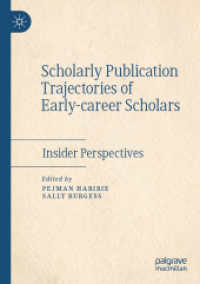Full Description
This book is about media, mediation, and meaning. The Art of Interpretation focuses on a set of interrelated processes whereby ostensibly human-specific modes of meaning become automated by machines, formatted by protocols, and networked by infrastructures. That is, as computation replaces interpretation, information effaces meaning, and infrastructure displaces interaction. Or so it seems.
Paul Kockelman asks: What does it take to automate, format, and network meaningful practices? What difference does this make for those who engage in such practices? And what is at stake? Reciprocally: How can we better understand computational processes from the standpoint of meaningful practices? How can we leverage such processes to better understand such practices? And what lies in wait? In answering these questions, Kockelman stays very close to fundamental concerns of computer science that emerged in the first half of the twentieth-century. Rather than foreground the latest application, technology or interface, he accounts for processes that underlie each and every digital technology deployed today.
In a novel method, The Art of Interpretation leverages key ideas of American pragmatism-a philosophical stance that understands the world, and our relation to it, in a way that avoids many of the conundrums and criticisms of conventional twentieth-century social theory. It puts this stance in dialogue with certain currents, and key texts, in anthropology and linguistics, science and technology studies, critical theory, computer science, and media studies.
Contents
1. Lines Crossed and Circles Breached
1. Semiotic Practices and Computational Processes
2. Lines (and How to Cross Them)
3. Circles (and How To Breach Them)
4. The Semiotic Stance
5. Overview of Chapters
2. Enemies, Parasites, and Noise
1. The Burning of Bridges
2. Channel, Infrastructure, and Institution
3. Shannon and Jakobson
4. Serres and Peirce
5. Jakobson and Serres
6. The Proliferation of Parasites
7. Enclosure, Disclosure, and Value
3. Poetry, Secrecy, and Being-Free
1. The Structure (and Event) of Networks
2. Degrees of Freedom
3. Frames of Relevance, Scales of Resolution
4. Sense and Sensibility
5. Enemies and Insecurities
6. The Poetics of Channels, The Secrets of Infrastructure
7. Residence without Representation
4. Meaning, Information, and Enclosure
1. From Tracing to Effacing
2. MacKay's Account of Information and Meaning
3. The Value of Information
4. Peirce's Account of Meaning
5. Peirce's Account of Information
6. Selfhood and Social Networks
7. From the Beautiful to the Sublime
5. Materiality, Virtuality, and Temporality
1. How to Buy Yourself a Night in Minecraft
2. Why Archeology is So 'Hard'
3. Figuring Grounds, Grice and Freud
4. Singularities and Replicas, Qualia and Aura
5. Deleuze's Understanding of the Virtual
6. Peirce's Understanding of the Virtual
7. Ontology and Virtuality
6. Computation, Interpretation, and Mediation
1. Sifters and Shifters
2. Sieving Symbols and Symbolizing Sieves
3. Linguistic Anthropology in the Age of Language Automata
4. Kinds of Languages, Kinds of Computers
5. Universal Grammar and Linguistic Relativity
6. Virtuality, Happiness, and Secret Roads to Recognition
7. Intermediation as Topic and Technique
7. Algorithms, Agents, and Ontologies
1. The Sabotaging of Sieves
2. The Ontology of Spam, Meteorites, and Huckleberry Finn
3. Ontologies in Transformation, Ontologies of Transformation
4. Testing Turing
5. Bayesian Anthropology
6. Virtuality and Actuality Revisited
7. Meaning, Mathematics, and Meat






